| Oracle® Fusion Middleware Configuration Guide for Oracle Business Intelligence Applications 11g Release (11.1.1) Part Number E16814-02 |
|
|
PDF · Mobi · ePub |
| Oracle® Fusion Middleware Configuration Guide for Oracle Business Intelligence Applications 11g Release (11.1.1) Part Number E16814-02 |
|
|
PDF · Mobi · ePub |
This section contains additional tasks relating to the Oracle BI Applications Configuration Manager, DAC Client and DAC Server, and Informatica PowerCenter Client Tools. It contains the following topics:
Section A.1, "Enabling DAC Client Communication with Informatica PowerCenter"
Section A.2, "Enabling DAC Server Communication with Informatica PowerCenter"
Section A.3, "How to Log Into Informatica PowerCenter Administration Console"
Section A.4, "How to Start Oracle BI Applications Configuration Manager"
Section A.5, "Optimizing a Repository File (RPD) for Oracle BI Applications"
Section A.6, "Verifying Duty Roles required for Oracle BI Applications"
The DAC Client uses the Informatica pmrep and pmcmd command line programs when communicating with Informatica PowerCenter. The DAC Client uses pmrep to synchronize DAC tasks with Informatica workflows and to keep the DAC task source and target tables information up to date.
In order for the DAC Client to be able to use the pmrep and pmcmd programs, the path of the Informatica Domain file 'domains.infa' must be defined in the environment variables on the DAC Client machine.
When you install DAC using the DAC installer, the Informatica Domain file is defined in the environment variables on the DAC Client machine. Therefore, if you installed DAC using the DAC installer, you do not need to perform the procedures in this section.
You should only perform the procedures in this section if you installed the DAC Client by copying the \DAC folder from one machine to another.
This section includes the following topics:
In order for the DAC Client to be able to use the pmrep and pmcmd programs, the path of the Informatica Domain file 'domains.infa' must be defined in the environment variables on the DAC Client machine.
Note: When you use the DAC installer to install the DAC Client, this configuration is done automatically.
To define the Informatica Domains File path in the DAC Client environment variables
Locate the file domains.infa in the root Informatica PowerCenter installation directory and note down the directory path of this file.
For example, <drive>:\Informatica\PowerCenter8.6.1.
Create an environment variable called INFA_DOMAINS_FILE with the value set to the directory path to the domans.infa file, as follows:
On Windows, display the Windows Environment Variables dialog box (that is, from the Windows Control Panel, select System, then Advanced, then Environment Variables), and create a System variable with the following values:
Variable name: INFA_DOMAINS_FILE
Variable value: <directory path of domains file>\domains.infa
The path should include the name of the file. For example, '<drive>:\Informatica\PowerCenter8.6.1\domains.infa'.
Add the directory path to Informatica PowerCenter binaries to the PATH environment variable as follows:
In the Windows System Properties > Environment Variables dialog box, add the path of the Informatica \Client\bin directory to the PATH environment variable. For example: <drive>:\Informatica\PowerCenter8.6.1\client\bin.
From a Windows command prompt, execute pmrep and then pmcmd. The test is successful if you see the programs are invoked and the pmrep and pmcmd prompts appear.
If pmrep and pmcmd are not recognized, then:
Ensure Hotfix 6 has been applied to Informatica PowerCenter 8.6.1.
Verify that the INFA_DOMAINS_FILE variable points to the domains.infa file located in the Informatica directory.
Verify that the PATH variable includes the path to the Informatica binaries (\Informatica\PowerCenter\client\bin), and that pmrep.exe and pmcmd.exe exist in the \bin folder.
The DAC Server uses the following command line programs to communicate with Informatica PowerCenter:
pmrep is used to communicate with PowerCenter Repository Services.
pmcmd is used to communicate with PowerCenter Integration Services to run the Informatica workflows.
The pmrep and pmcmd programs are installed during the PowerCenter Services installation in the bin folder of the server directory.
For the DAC Server to be able to communicate with PowerCenter Services using the pmrep and pmcmd, the path of the Informatica Domain file 'domains.infa' must be defined and certain environment variables must be set. When you install the DAC Server on Windows or Linux using the DAC installer, this configuration is done automatically. Therefore, if you installed the DAC Server using the DAC installer, you do not need to perform the procedures in this section.
If you installed the DAC Server on UNIX, you need to perform the procedure in Section A.2.2, "How to Set Environment Variables for DAC Server Communication on UNIX."
This section includes the following topics:
Section A.2.1, "How to Set Environment Variables for DAC Server Communication on Windows"
Section A.2.2, "How to Set Environment Variables for DAC Server Communication on UNIX"
Section A.2.3, "How to Verify Java JDK Availability and Version"
Follow this procedure to set environment variables on Windows.
Note: When you use the DAC installer to install the DAC Server, this configuration is done automatically.
To set the environment variables on Windows
Locate the file domains.infa in the root Informatica PowerCenter installation directory and note down the directory path of this file.
For example, D:\Informatica\PowerCenter8.6.1.
Create an environment variable called INFA_DOMAINS_FILE with the value set to the directory path to the domans.infa file, as follows:
On Windows, display the Windows Environment Variables dialog box (that is, from the Windows Control Panel, select System, then Advanced, then Environment Variables), and create a System variable with the following values:
Variable name: INFA_DOMAINS_FILE
Variable value: <<directory path of domain file>\domains.infa>
The Variable value should include the domains.infa file name. For example, D:\Informatica\PowerCenter8.6.1\domains.infa.
Add the directory path to Informatica PowerCenter binaries to the PATH environment variable as follows:
In the Windows System Properties > Environment Variables dialog box, add the path of the Informatica \server\bin directory to the PATH environment variable. For example: <drive>:\Informatica\PowerCenter8.6.1\server\bin.
How to Verify the DAC Server Is Able to Use pmrep and pmcmd
From a Windows command prompt, execute pmrep and then pmcmd. The test is successful if the pmrep and pmcmd prompts appear.
If pmrep and pmcmd are not recognized, then:
Ensure Hotfix 6 has been applied to Informatica PowerCenter 8.6.1.
Verify that the INFA_DOMAINS_FILE variable points to the domains.infa file located in the Informatica directory.
Verify that the PATH variable includes the path to the Informatica binaries (\Informatica\PowerCenter\server\bin).
This procedure is required for DAC Server deployments on UNIX.
Note: When you use the DAC installer to install the DAC Server on Linux, this configuration is done automatically.
To set environment variables for DAC Server Communication on UNIX
Navigate to the /DAC directory.
Open the dac_env.sh file for editing.
Note: The files dac_env_714.sh and dac_env_811.sh are backup files used for Information PowerCenter deployments prior to version 8.6.1.
Set the value for each instance of the variable %INFORMATICA_SERVER_LOCATION% to the directory that contains the Informatica server directory. (Do not include the server directory.)
For example, change the following line from:
DAC_PMCMD_PATH=%INFORMATICA_SERVER_LOCATION%/server/bin
to
DAC_PMCMD_PATH=Informatica/PowerCenter8.6.1/server/bin
Set the value for each instance of the variable %DOMAINS.INFA_FILE_LOCATION% to the directory that contains the domains.infa file. (Include the file name in the value.)
For example, change the following line from:
export INFA_DOMAINS_FILE=%DOMAINS.INFA_FILE_LOCATION%
to
export INFA_DOMAINS_FILE=Informatica/PowerCenter8.6.1/domains.infa
If necessary, uncomment the locale settings.
How to Verify the DAC Server on UNIX or Linux Is Able to Use pmrep and pmcmd
Invoke config.sh to set environment. For example, . ./config.sh. Then, invoke pmcmd.
Make sure that invoking pmcmd starts the pmcmd shell. If you get a 'command not found' error, then the location of the PowerCenter Services is not properly added to PATH in dac_env.sh. Review all environment variable settings to ensure they are correctly set.
Then, invoke pmrep, and make sure that invoking pmrep starts the pmrep shell. If you get a 'command not found' error, then the location of the PowerCenter Services is not properly added to PATH in dac_env.sh. Review all environment variable settings to ensure they are correctly set.
On some shells, export commands in dac_env.sh and config.sh might not work correctly. In this case, try breaking the commands in two. For example, from:
export JAVA_HOME=/opt/java1.6
To:
JAVA_HOME=/opt/java1.6 export JAVA_HOME
To verify that the DAC Server uses the correct Java JDK:
Invoke config.sh to set environment.
For example:
. ./config.sh
Verify Java availability and version by typing the following command:
$JAVA –version
The Java version is returned.
If you receive a 'command not found' error message, or the Java version is lower than 1.6, then the JAVA_HOME parameter in config.sh is pointing to a non-existent or incorrect Java JDK location.
Informatica PowerCenter Administration Console is installed on the machine that hosts the gateway node for the PowerCenter domain. For a single machine install of PowerCenter Services as described in this chapter, PowerCenter Administration Console is installed along with PowerCenter Services.
To log into PowerCenter Administration Console
In a supported Web browser, access the following URL:
http://<gateway host>:<domain port>
Where:
<gateway host> is the name of the machine on which the gateway node has been configured; for a single-machine installation of PowerCenter Services it is the name of the machine on which PowerCenter Services has been installed.
<domain port> is the port number for the gateway. The default port number is 6001.
In the login page, enter the domain user name and password that was specified when you created the domain during installation of PowerCenter Services (for example, admin\admin).
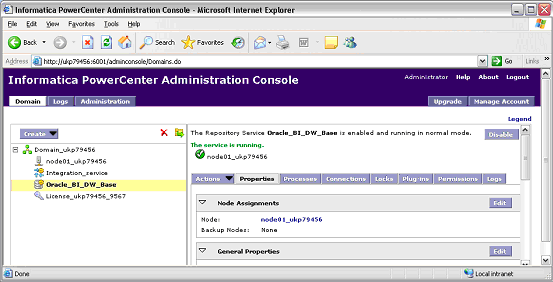
You use Oracle BI Applications Configuration Manager to set up and manage several aspects of the Oracle BI Applications environment, and to manage and monitor Functional Configurations for Oracle BI Applications Offerings.
To start Oracle BI Applications Configuration Manager:
In a Web browser, enter the Oracle BI Applications Configuration Manager URL which your System Administrator provides you.
For example:
http://HOST.MYCOMPANY.COM:PORT/biacm/
The Oracle BI Applications Configuration Manager Login dialog is displayed.
In the Login screen, log in with your user credentials.
Note: Your User Login must be associated to the appropriate Duty Role. For more information see Section 5.4, "About Users and Roles in Oracle BI Applications Configuration Manager". If you do not have access to Oracle BI Applications Configuration Manager or have incorrect access, then contact your Security Administrator.
The main Oracle BI Applications Configuration Manager page is displayed.
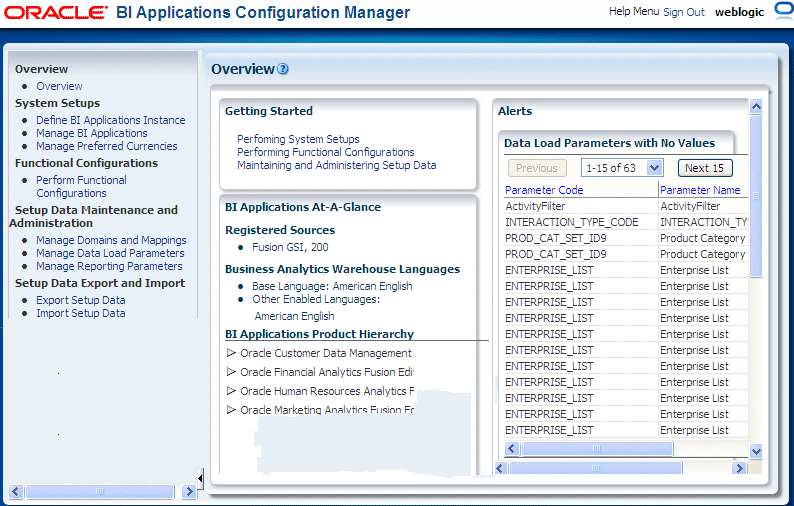
Notes
Use the Tasks bar on the left-hand side of the Welcome page to navigate the application.
The options that are displayed in the Tasks bar are dependent on the privileges of the user name that you log in with.
Click Help to display the additional User Assistance in the context-sensitive Help system.
To log out of Oracle BI Applications Configuration Manager, select the Sign out link in the top right hand corner.
This section provides instructions for optimizing a BI repository (RPD file), and contains the following topics:
Section A.5.1, "Overview of Optimizing the Repository File (RPD) for Oracle BI Applications"
Section A.5.3, "Merging Repositories for Oracle BI Applications Projects"
Oracle Fusion Applications provides a full RPD file with all projects for both Oracle Transactional Business Intelligence and Oracle BI Applications. In fact, there are three RPDs—the full RPD, one that contains only the CRM projects for both Oracle Transactional Business Intelligence and Oracle BI Applications, and one that contains only ERP projects, also for both Oracle Transactional Business Intelligence and Oracle BI Applications. See your installation for the names of the three RPDs. With Oracle BI Applications provisioning, the full RPD is deployed to the BI Server.
You can optimize the RPD so that it includes only the projects that are relevant to your deployment. Although optional, optimizing the RPD makes BI Server startup faster and also makes patching quicker.
The steps for optimizing the RPD for Oracle BI Applications depend on the status of your deployment:
If the RPD for Oracle Transactional Business Intelligence was previously optimized or customized for your deployment, extract the Oracle BI Applications projects from the full RPD and then merge that RPD with the one for Oracle Transactional Business Intelligence. See Section A.5.2, "Extracting Oracle BI Applications Projects" and Section A.5.3, "Merging Repositories for Oracle BI Applications Projects".
If the RPD for Oracle Transactional Business Intelligence was not previously optimized or customized for your deployment, extract the Oracle Transactional Business Intelligence and Oracle BI Applications projects for the products that you or your organization purchased. You do not need to perform a merge. See Section A.5.2, "Extracting Oracle BI Applications Projects" only.
Note:
To find out if Oracle Transactional Business Intelligence was previously deployed by your organization, contact your system administrator.Follow the procedure in this topic to extract Oracle BI Applications projects.
To extract Oracle BI Applications projects from the RPD:
Open a command window on the computer where the Administration Tool for your deployment is installed.
Run bi-init.cmd (or bi-init.sh on UNIX systems) to launch a command prompt that is initialized to your Oracle instance. You can find this utility in:
ORACLE_INSTANCE/bifoundation/OracleBIApplication/coreapplication/setup
In the command prompt, change to the following directory:
MW_HOME\Oracle_BI1\bifoundation\server\bin
Run the following command:
ExtractProjects -B input_rpd -O output_rpd -I "project_name"
where:
input_rpd is the name and path of the RPD from which you want to extract the Oracle BI Applications project (for example, OracleBIApps.rpd)
output_rpd is the name and path of the RPD you want to create with the extracted Oracle BI Applications project (for example, OracleBIAppsBIAonly.rpd)
project_name is the name of the Oracle BI Applications project you want to extract
You will be prompted to enter the password for the RPD from which you are extracting the Oracle BI Applications project (input_rpd ).
To extract multiple projects, run the following command:
ExtractProjects -B input_rpd -O output_rpd -I "project_name1" -I "project_name2" -I "project_name3" (and so on)
The list of Oracle BI Applications projects in the RPD include the following:
Customer Data Management Analytics Fusion Edition
Financial Analytics Fusion Edition
Human Resources Analytics Fusion Edition
Marketing Analytics Fusion Edition
Partner Analytics Fusion Edition
Procurement and Spend Analytics Fusion Edition
Product Information Management Analytics Fusion Edition
Project Analytics Fusion Edition
Sales Analytics Fusion Edition
Supply Chain and Order Management Analytics Fusion Edition
Follow the procedure in this topic only if you previously optimized or customized the repository for Oracle Transactional Business Intelligence. If you did not previously optimize or customize the repository for Oracle Fusion Transactional Business Intelligence, you can ignore this topic and the following procedure.
To merge repositories for Oracle BI Applications projects:
In the Administration Tool, open in offline mode the Oracle BI repository that you created in Step 4 of Section A.5.2, "Extracting Oracle BI Applications Projects".
On the Administration Tool menu bar, click File and then Merge.
In the Select Original Repository dialog box, select the repository OracleBIApps.rpd.
Type the password for the original repository, and then click OK.
Click Select for the Modified Repository field. The Select Modified Repository dialog box opens.
In the Select Modified Repository dialog box, select the repository that contains the customizations you made to the previous RPD file (for example, OracleBIAppsOTBIonly.rpd).
Click Open, type the password for the previously customized RPD file, and then click OK.
In the Decision drop-down list, select the action you want to take regarding the repository change, or accept the default action.
To locate subsequent rows with empty Decision fields, click the Decision header cell. After all rows have a value in the Decision field, the Merge button becomes enabled.
Click Merge. A message appears after the merge concludes successfully.
On the File menu, click Save As, and save the current repository using a new name, such as OracleBIAppsFinal.rpd.
This section explains how to verify that Duty Roles for Oracle BI Applications are correctly mapped to Fusion Applications Enterprise Roles.
A list of required Enterprise Roles and Duty Roles for Oracle BI Applications is published on My Oracle Support (ID 1333454.1.) as a spreadsheet named 'Oracle Business Intelligence Applications Duty Role Assignments for Fusion Applications'.
The spreadsheet contains a sheet for each Oracle BI Applications Offering. For example, Oracle Financial Analytics, Oracle HR Analytics, and so on. Each sheet shows the following information:
The Fusion Applications Enterprise Job Roles in column A.
The associated Duty Roles in column B.
The Presentation Catalog areas mapped to the Duty Role in Column C.
The other columns show information, such as the modules to which the roles apply.
The example screenshot below shows a section from the Finance sheet, which contains Duty Roles for Oracle Financial Analytics.
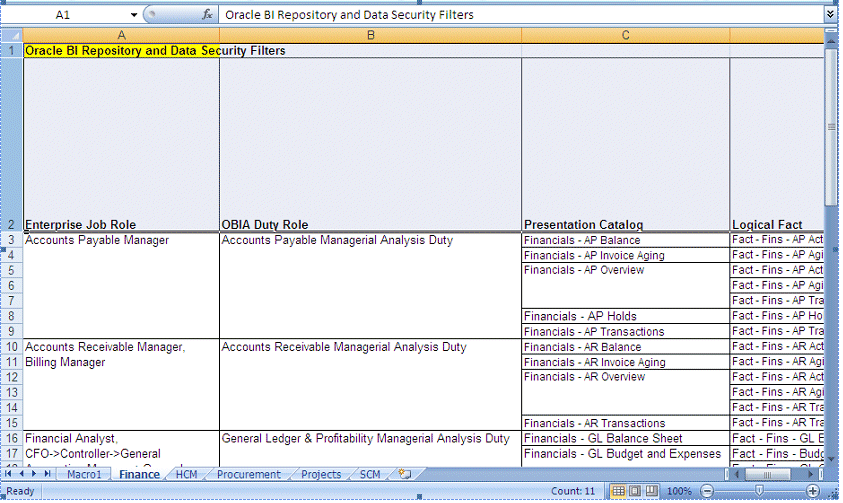
To verify that Duty Roles are mapped to Enterprise Roles, do the following:
Download the spreadsheet named 'Oracle Business Intelligence Applications Duty Role Assignments for Fusion Applications', which is available on My Oracle Review as ID 1333454.1.
Use Oracle APM to verify that Duty Roles are mapped to the appropriate Enterprise Roles, as follows:
In Oracle APM, navigate to the 'obi' Application and use the Search options to locate Duty Roles prefixed with 'OBIA_'.
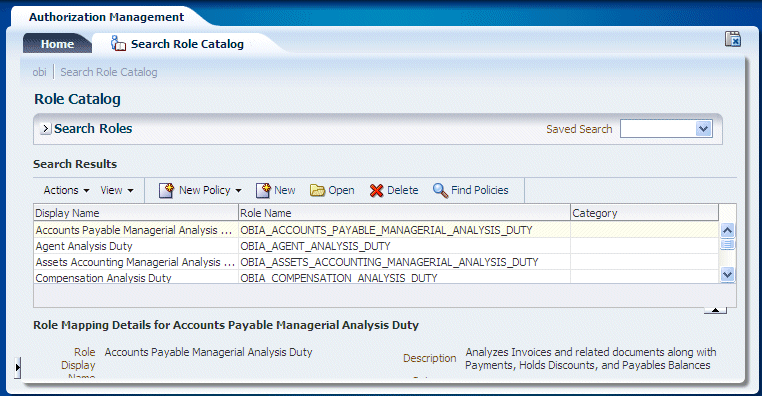
Select each Duty Role, then click Open to display the <Application> | Application Role dialog.
Display the External Role Mapping tab, and check that the role list contains the appropriate Enterprise Roles.
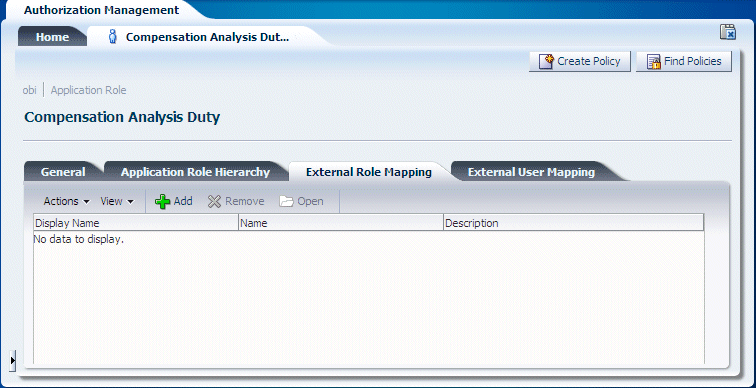
Use the spreadsheet 'Oracle Business Intelligence Applications Duty Role Assignments for Fusion Applications' to determine which Enterprise Roles should be displayed in the role list.
If you need to re-map Fusion Applications Enterprise Roles to Duty Roles, do the following:
In Oracle APM, navigate to the 'obi' Application and use the Search options to locate and select the Duty Role in the role list.
Click Open to display the <Application> | Application Role dialog.
Display the External Role Mapping tab.

Use the External Role Mapping tab to search for and select the Fusion Applications Enterprise Roles that must be mapped to that Duty Role.
Click Add to display the External Role Search dialog, which enables you to locate Enterprise Roles in the LDAP directory.

For example, the OBIA_WORKFORCE_DEPLOYMENT_ANALYSIS_DUTY Duty Role must be mapped to the PER_LINE_MANAGER_ABSTRACT Job Role and the PER_HUMAN_RESOURCES_VP_JOB Job Role.
Click Map Roles to map selected Enterprise Roles to the Duty Role, and return to the External Role Mapping tab.
For more information about using Oracle APM to manage Duty Roles and Enterprise Roles, refer to Oracle Fusion Middleware Oracle Authorization Policy Manager Administrator's Guide (Oracle Fusion Applications Edition).